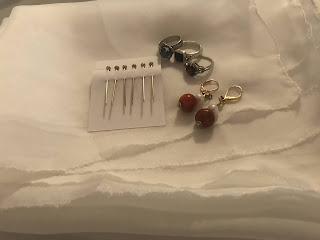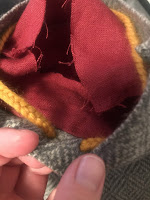 |
| I like to use sheer linen, but there are plenty of other fabric choices that work just as well. |
 |
| I find flat felled seams to be the most comfortable finishing method for undergarments. |
 |
| I like to use sheer linen, but there are plenty of other fabric choices that work just as well. |
 |
| I find flat felled seams to be the most comfortable finishing method for undergarments. |
 |
| Partlet for a 1560s/70s Venetian outfit |
 |
| Apron embroidery |
 |
I've also done a lot of planning work for upcoming projects. Working out the pattern for the jerkin gave me the bodice pattern I need for a fitted gown I'll be making this winter. I'm in the middle of researching arming doublets of the mid to late 14th century as part of my brother's 14th century knight's gear. I've mostly designed a 16th century Italian working class outfit I'd like to make for hot days at Faire in 2021. I've figured out what pieces I'll need to make for the 15th century Florentine ensemble my mother wants, which meant hours of looking at 15th century art and showing her recreations of gowns. I took advantage of Black Friday to get a lot of supplies for upcoming projects, including a German Trossfrau dress I've been wanting to make since I first saw pictures of them.
 |
| Gold silk jerkin |
I've also been working on getting an Etsy shop going for historical clothing. Deciding how to stock it has been a challenge, though. Some stock items, and other things made to order, perhaps? I hope to have my shop going in the new year, so I'd better hurry up and figure it out!
So all in all, it's been a productive two months or so since I last posted, but it's also been the kind of productive that doesn't really mean a lot of pictures here. Don't worry, it's all coming soon!
 |
| Blue velvet gown, not quite finished |
It's really more of a practice run in sheer linen for a partlet I'm planning to make in silk when I have time to actually take my time and do things carefully, but I'm very pleased with how it turned out. And it looked great with my new black dress at an event over the weekend, so that was nice. What I wanted was something along the lines of the partlets in a lot of northern Italian art from the 1550's and 60's that are very simply constructed out of linen or silk, and have a low ruffled collar, rather than a large ruff attached.
This Portrait of a Lady and her Daughter, by Titian from around 1550 is exactly the sort of thing I had in mind for a fancy silk partlet, and I figured I should probably try it in linen first. Besides, one can never really have too many partlets, can one? It's hard to tell due to the painting being unfinished, but the partlet looks like it's about the same weight fabric as the camicia, so it may be linen, but you see partlets like it, with the small ruffle but not really much other decoration frequently in all sorts of sheer materials across northern and central Italy and throughout the period. I really love everything about this portrait; this is one of several images that led me to settle on mid 16th century Venice for the majority of my historical wardrobe in the first place, and this gown was also a major source of inspiration for my blue dress, so I'm really excited to have the partlet to match! I just bought a few yards of gold silk taffeta on sale, too, so I could have the whole ensemble... But that's a project for another day, when I have more time!This partlet came together really quickly! I started with the partlet pattern I used for my Venetian falling ruff, and adjusted slightly to make the shoulders just a little wider. My ruff tends to come un-tucked from my shoulder straps, which isn't really ideal, but adding another couple of inches to the shoulders fixed the problem. First, I cut out my 2 front pieces, one back piece, and and a couple of long, skinny strips of linen to make the ruffle. I decided to omit the collar for this partlet, since several of the portraits that inspired this piece don't appear to have any collar apart from the ruffle.
First I sewed up and then flat felled the shoulder seams, just like I had on my ruff. I then tried the partlet on to determine how much of a neck hole I should cut out, since I was lazy and didn't draft that into the pattern. I cut out a 3/4 circle at the shoulders and top back, tried it on again to make sure it fit, and then hemmed all the edges with a little rolled hem. Yay, functional partlet!
 |
| Attaching the ruffle |
 |
| Stitching it to the partlet |
Then I went on to the ruffle. I stitched the strips of linen I had cut together with tiny flat felled seams to make a single piece about 2 inches wide by 38 inches long. I then made a tiny rolled hem all the may around. Next, I made 1/2 inch gathering stitches on one side, and gathered and stitched the ruffle to the partlet. I tried it on and found that the ruffle was a little floppier than I wanted, so I tacked it to the partlet all the way around. Finally, I sewed some ribbon ties on under the arms and a hook and eye at the front. Partlet complete! And it didn't even take a full day to do by hand! And I got to wear it for a party, so both it and the dress have made their public debut! Much excitement!
 |
| We didn't take a lot of pictures at our event, so this is just about the only one of me in this partlet. |




 |
| Bodice front boning and pad stitching. This is pretty much the same pattern as my bodies, but the 3 center bones almost function like a busk, so I get plenty of support with fewer bones. |
 |
| Lining the bodice. |
 |
| Yay, guards! |
 |
| Pieced skirt lining, lined up with the fashion fabric. |
 |
| Note the awkwardly short skirt front... Oops! |
 |
| Attaching the guard... |
 |
| And covering the seam! No one will ever notice, right?! |
 |
| Probably the most attractive picture ever taken of me... Away, thou plague sore! Or something equally disgusted and Shakespearean... Yes, this is the one I'm using for the Instagram post! |
 |
| Titian, circa 1560 |
 |
| Queen Elizabeth I of England, painted 1567. |
 |
| Measuring my cartridge pleats |
 |
| Definitely not historical, but just as stiff as the jute rope and slightly lighter. |
 |
 |
| Too long! Don't mind the stray shoe... |
 |
| Look at all the poof! So much better! |
 |
| Green dress without the petticoat. |
 |
| Failing a bit at "serious Renaissance portrait face," but you can see the new accessories pretty well in this shot. Don't mind the modern second ear piercings I forgot to take out for pictures! |
 |
| All the new things, plus the 2 rings I already had that can pass for Italian Renaissance. I'm really pleased with my new earrings! |
 |
| Better serious Renaissance face here! Unfortunately, Colorado looks nothing like Venice. |
 |
| Another veil pic. Because I think my veil is awesome. So flowy and cute! I need to get better at pinning it, though. |
 |
| The grey wool hood fabric and the red linen dress fabric look cute together, so why not use them, right? |
 |
| Making the drawstring channel. Lots of pins to hold the fabric in place. |
 |
| Inserting the drawstring |
 |
| Closing the channel and finishing the edges. |
 |
| The last step! Whip stitching the strap to the bag. |